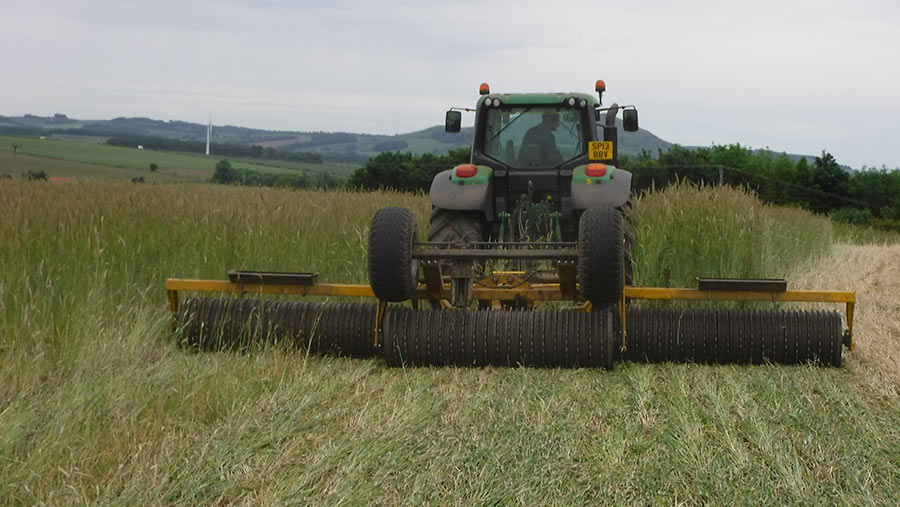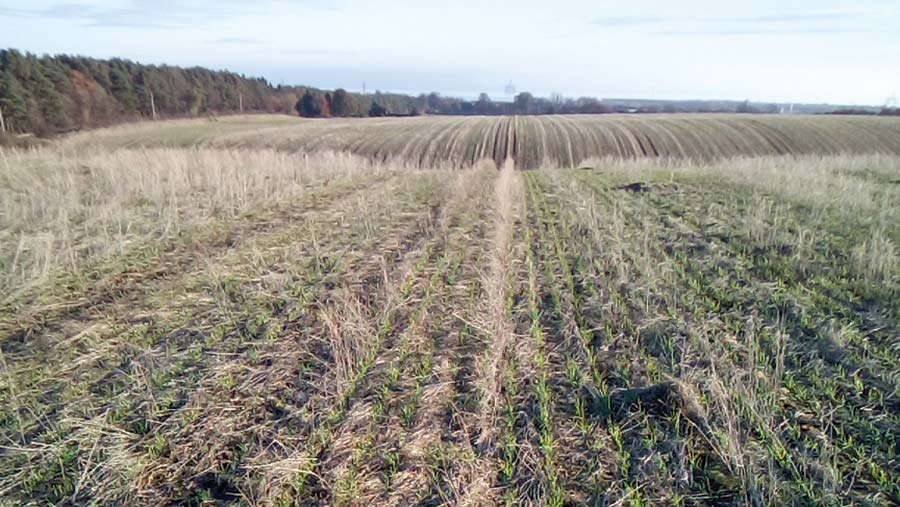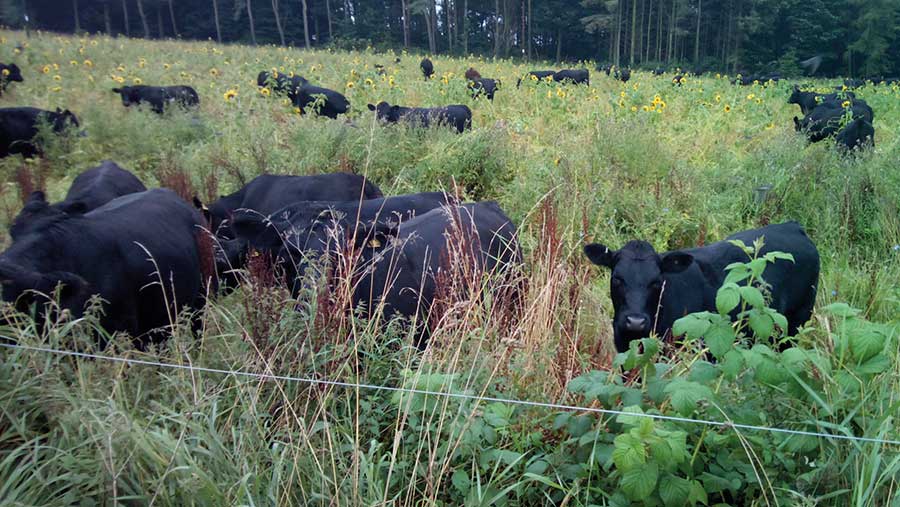20 years of regenerative agriculture: One farm’s success story
 © Doug Christie
© Doug Christie What started as a cost-cutting exercise more than 20 years ago on Doug Christie’s 570ha farm in Fife has developed into a regenerative system that ticks all the boxes and shows what can be achieved with a stockless arable rotation.
Although there is also an organic beef enterprise on Durie Farms, near Leven, the manures cannot be used on his conventional land under organic rules, so he has had to find other ways of enhancing soils and making the arable enterprise sustainable.
By eliminating soil disturbance, introducing cover crops, using compost and having a very flexible rotation – as well as keeping an open mind – Mr Christie has seen soil organic matter levels rise slowly over time and soil conditions improve.
As a result, input use has fallen and biodiversity has flourished, with the system continuing to mature and evolve as he tests out new practices and ideas, integrating those that work on his sandy loam soils.
Making mistakes

Doug Christie © Doug Christie
Describing his actions as “tinkering around since 2000”, Mr Christie admits to making plenty of mistakes along the way.
“I was seen as an oddity in the area when I stopped ploughing. Moving to a regenerative system is a mindset change, and once I’d made a start I realised that there was much more to it than just saving money,” he says.
Trips to France and the US with regenerative farmer organisation Base (Biodiversity-Agriculture-Soil-Environment) in the early days helped him to understand how it could work, despite the geographical and climatic differences.
He began by including cover crops in a more diverse rotation, so that maximum use of living roots was made and soil biology benefited.
Based on two cereals and a break crop, the rotation is now dominated by spring cropping – all of which has a multispecies cover crop grown ahead of it. With no blueprint, it is open to change at any moment and cover crop mixes are flexible.

© Doug Christie
Cover crops
“They’re not expensive mixes. I started by using mustard and oats, but now I aim to get as many species in as possible. The only issue for us is rye – it turned out to be a host for BYDV [barley yellow dwarf virus] and we don’t use any insecticides on the farm,” he says.
The covers are established straight after the combine, which can be quite late in Scotland. “But we’ve had success with cover crops planted in September and it’s always better to have something there than not, even if it is small,” adds Mr Christie.
“In general, the further north you go, the more difficult it gets. That’s why it’s important to speak to other farmers and see how they’re making things work. Broadcasting the cover crop seed into a standing wheat crop is an option I’d like to try,” he says.
Destruction of cover crops is mainly done with glyphosate, although he has had success with rolling in the frost and would always prefer not to spray.
“Much depends on what’s going in next – we have to be flexible on both destruction method and date for that reason,” he says.
Break crops

Beans and oats © Doug Christie
Companion crops are grown with all of his break crops, which does mean that Mr Christie bears the costs of separating them. Although winter oilseed rape has now been dropped, he has had success with a spring oilseed rape/peas/oats mix, which only received 20kg/ha of nitrogen and a small amount of herbicide.
“A beans and oats mix also works well and gives us a way of reducing risk. If cleavers come in, we can spray them and take out the beans as well, if brome is an issue, we can remove it with the oats,” he says.
Growing a legume every three years allows him to reduce the use of artificial nitrogen, which has a knock-on effect on other inputs. He is now spending a maximum of £50/ha on winter wheat fungicides and hopes to reduce that further.
“A high-input system carries much more risk, especially if the weather goes against you,” he says.
Experimentation
Having used various drills on his stony soils over the past 20 years, Mr Christie is very pleased with his current 6m John Dale drill, which uses just 4.5 litre/ha of fuel.
He also has a Moore Uni-drill and bought a stripper header last year, so that he can drill into standing straw and manage residues.
“I’m always trying new things. At the moment, I’m looking at how I can bring a perennial crop into the rotation, as a means of reducing weed build-up,” he says.
Financially, he doesn’t believe the business is doing any better than if he’d continued with his old system, but his soils and the wider environment are in better shape and his business is on a much firmer footing for the future.
Compared with a neighbouring farm, which has lost 1.5% organic matter in the past 10-15 years, his soils have increased by 0.5%, so there’s now a 2% difference between them.
Long-term results
Yields haven’t changed, but his fertiliser use is down by one-third, fuel use has been cut dramatically and other inputs are only used sparingly. Insecticides and seed treatments don’t feature any more.
In addition, earthworm numbers and bird populations are on the up, while soils are cycling nutrients and are far less susceptible to extreme weather events.
“It’s made my life easier, but there is more management involved. When I started, the practice was ahead of the science and farmer-to-farmer learning was invaluable,” he says.
“Now there are many more Base farmers in Scotland and the research institutes are keen to interact. There’s a much bigger support network and more people are giving it a go,” adds Mr Christie.
Mob grazing at Durie Farms

© Doug Christie
On the third of the farm devoted to organic beef production, Mr Christie introduced mob grazing almost three years ago and moves his Aberdeen Angus cattle on a daily basis so that grass has longer to recover.
Having spent money on the infrastructure, he is now reaping the rewards. The cattle stay outside for much longer and the fuel use associated with winter bedding and feeding has come right down.
“I was using more fuel on the livestock enterprise a hectare than I was on growing crops. Since I changed, it’s been better for the soils and better for the cattle,” he says.
Organic methods are a no-brainer with livestock. “I grow around 40ha of crops and only have to buy in minerals and occasionally bulls, a small amount of fertiliser and lime and some seed. It’s a cheaper and cleverer way of doing it,” he says.
Mr Christie would like to increase cattle numbers and bring grass into his arable rotation, which would involve the whole farm converting to organic.
“It’s certainly a good way of bringing a perennial into the rotation, but going organic without using cultivations is almost impossible to do,” he says.

